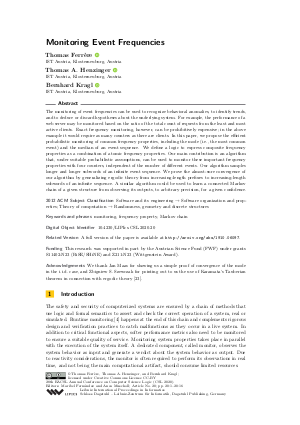@InProceedings{ferrere_et_al:LIPIcs.CSL.2020.20,
author = {Ferr\`{e}re, Thomas and Henzinger, Thomas A. and Kragl, Bernhard},
title = {{Monitoring Event Frequencies}},
booktitle = {28th EACSL Annual Conference on Computer Science Logic (CSL 2020)},
pages = {20:1--20:16},
series = {Leibniz International Proceedings in Informatics (LIPIcs)},
ISBN = {978-3-95977-132-0},
ISSN = {1868-8969},
year = {2020},
volume = {152},
editor = {Fern\'{a}ndez, Maribel and Muscholl, Anca},
publisher = {Schloss Dagstuhl -- Leibniz-Zentrum f{\"u}r Informatik},
address = {Dagstuhl, Germany},
URL = {https://drops.dagstuhl.de/entities/document/10.4230/LIPIcs.CSL.2020.20},
URN = {urn:nbn:de:0030-drops-116633},
doi = {10.4230/LIPIcs.CSL.2020.20},
annote = {Keywords: monitoring, frequency property, Markov chain}
}

 Creative Commons Attribution 3.0 Unported license
Creative Commons Attribution 3.0 Unported license

